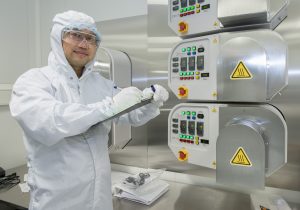- Realizing in-situ magnetic phase transition in metallic van-der-Waals magnet Fe5GeTe2 via ultra-high charge doping
A RMIT-led international collaboration published this week has achieved record-high electron doping in a layered ferromagnet, causing magnetic phase transition with significant promise for future electronics
Control of magnetism (or spin directions) by electric voltage is vital for developing future, low-energy high-speed nano-electronic and spintronic devices, such as spin-orbit torque devices and spin field-effect transistors.
Ultra-high-charge, doping-induced magnetic phase transition in a layered ferromagnet allows promising applications in antiferromagnetic spintronic devices.
The FLEET collaboration of researchers at RMIT, UNSW, the University of Wollongong and FLEET partner High Magnetic Field Laboratory (China) demonstrates for the first time that ultra-high electron doping concentration (above 1021 cm-3) can be induced in the layered van der Waals (vdW) metallic material Fe5GeTe2 by proton intercalation, and can further cause a transition of the magnetic ground state from ferromagnetism to antiferromagnetism.
Tuning magnetism in the vdW ferromagnet Fe5GeTe2 (F5GT)
The emergence of layered, vdW magnetic materials has expedited a growing search for novel vdW spintronic devices.
Compared to itinerant ferromagnets, antiferromagnets (AFMs) have unique advantages as building blocks of such future spintronic devices. Their robustness to stray magnetic fields makes them suitable for memory devices, and the AFM-based spin-orbit torque devices require a lower current density than that in ferromagnets.
However currently vdW itinerant antiferromagnets are still scarce.
Besides directly synthesizing a vdW antiferromagnet, another possible method toward this function is to induce a magnetic phase transition in an existing vdW itinerant ferromagnet.
“We chose to work with newly synthesised vdW itinerant ferromagnet Fe5GeTe2 (F5GT)” says the study’s first author, FLEET Research Fellow Dr Cheng Tan (RMIT).
“Our previous experience on Fe3GeTe2 (Nature Communication 2018) enabled us to quickly identify and evaluate the material’s magnetic properties, and some studies indicate Fe5GeTe2 is sensitive to local atomic arrangements and interlayer stacking configurations, meaning it would be possible to induce a phase transition in it by doping,” Cheng says.
The team firstly investigated the magnetic properties in Fe5GeTe2 nanosheets of various thicknesses by electron transport measurements.
However, the initial transport results also show that the electron density in Fe5GeTe2 is high as expected, indicating that the magnetism is hard to be modulated by traditional gate-voltage due to the electric-screen effect in metal:
“Despite the high charge density in Fe5GeTe2, we knew it was worth trying to tune the material via protonic gating, as we have previously achieved in Fe3GeTe2 (Physical Review Letters 2020), because protons can easily penetrate into the interlayer and induce large charge doping, without damaging the lattice structure,” says co-author Dr Guolin Zheng (also at RMIT).
Fabricating the solid protonic field-effect transistor (SP-FET)
Like all classical-computing beyond-CMOS researchers, the team are seeking to build an improved form of the transistor, the switches that provide the binary backbone of modern electronics.
A solid protonic field-effect transistor (SP-FET) is one that switches based on insertion (intercalation) of protons. Unlike traditional proton FETs (which switch by dipping liquid, and are considered promising candidates for bridging between traditional electronics and biological systems. ), the SP-FET is solid, and thus suitable for use in real devices
The SP-FET has been demonstrated to be very powerful in tuning thick metallic materials (ie, it can induce large charge doping level), which are very difficult to modulate via traditional dielectric based or ion liquid gating techniques(because of electric screening effect in metal).
By fabricating a solid protonic field-effect transistor (SP-FET) with Fe5GeTe2, the team were able to dramatically change the carrier density in Fe5GeTe2 and change its magnetic ground state. Further density functional theory calculation confirmed the experimental results.
“All the samples show that the ferromagnetic state can be gradually supressed by increasing proton intercalation, and finally we see several samples display no hysteresis loops, which indicates the change of the magnetic ground state, the theoretical calculations are consistent with the experimental results,” says Cheng.
“The success of realizing an AFM phase in metallic vdW ferromagnet Fe5GeTe2 nanosheets constitutes an important step towards vdW antiferromagnetic devices and heterostructures that operate at high temperatures,” says co-author A/Prof Lan Wang (also at RMIT).
“Again, this demonstrates that our protonic gate technique is a powerful weapon in electron transport experiments, and probably in other areas well.”
The study
“Gate-controlled magnetic phase transition in a van der Waals magnet Fe5GeTe2” was published in Nano Letters in June 2021. (DOI: 10.1021/acs.nanolett.1c01108)
As well as support from the Australian Research Council, support was also provided by Natural Science Foundation of China, the National Key Research and Development Program of China, the Fundamental Research Funds for the Central Universities, the Collaborative Innovation Program of Hefei Science Center and the High Magnetic Field Laboratory (China).
Experimental research was performed at the RMIT Micro Nano Research Facility (MNRF) in the Victorian Node of the Australian National Fabrication Facility (ANFF) and the RMIT Microscopy and Microanalysis Facility (RMMF), as well as the High Magnetic Field Laboratory (Anhui, China).
Spintronic devices are studied within Enabling technology B at FLEET, an Australian Research Council Centre of Excellence. The Centre for Future Low-Energy Electronics Technologies (FLEET) brings together over a hundred Australian and international experts, with the shared mission to develop a new generation of ultra-low energy electronics. The impetus behind such work is the increasing challenge of energy used in computation, which uses 5–8% of global electricity and is doubling every decade.
More information
- Contact Dr Cheng Tan (RMIT) cheng.tan@rmit.edu.au
- Contact Dr Guolin Zheng (RMIT) guolin.zheng@rmit.edu.au
- Contact A/Prof Lan Wang (RMIT) lan.wang@rmit.edu.au
- Watch Future solutions to computation energy use
- Connect @FLEETCentre









